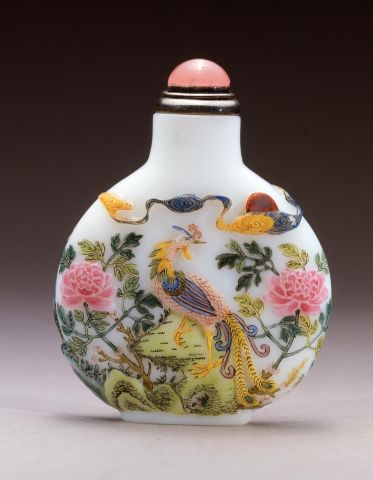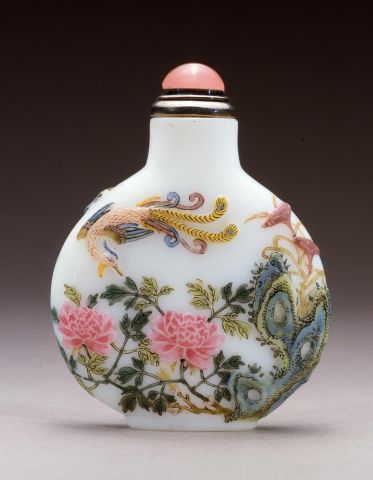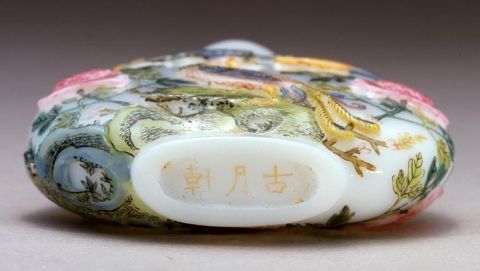


Bottle ID: 00203
YUANMING YUAN, WHITE, PHOENIX, SUN & CLOUDS W/LANDSCAPE
Date: 1767-1799
Height: 58 mm
Glass, milk-white, of flattened rounded form with a neatly carved footrim, the molded body decorated with famille rose enamels, with on one side a golden phoenix standing on a grassy bank below a bright red sun in scrolling clouds, surrounded by peonies; the reverse with a phoenix flying over a leafy flowering peony bush issuing from convoluted rockwork with lingzhi fungus growing from it; the base with an iron red three character Guyue Xuan mark.
Imperial, attributed to the Palace Workshops, Yuanming Yuan.
Similar Examples:
Lawrence, Clare. Miniature Masterpieces from the Middle Kingdom - The Monimar Collection of Chinese Snuff Bottles, 1996, pp. 16-17, no. 2.172.
Moss, Hugh M. [ed.] Chinese Snuff Bottles: 6, from the Collection of the Rt. Hon. The Marquess of Exeter, K.C.M.G., 1974, p. 101, no. E3.
Brown, Claudia and Donald Rabiner. The Robert H. Clague Collection - Chinese Glass of the Qing Dynasty, 1644-1911, pp. 46-47, no. 49.
Sotheby's, New York, September 14, 2010, lot 11, The Joe Grimberg Collection.
Provenance:
Clare Lawrence Ltd.
Sotheby's, Hong Kong, October 28, 1993, lot 1268
Societe Jersiaise
Eric Young
Lilla S. Perry
Exhibited:
Annual Convention ICSBS Toronto, October 2007
Published:
JICSBS, Winter 2008, p. 9, figs. 9a and 9b
JICSBS, Spring 2006, p. 29, fig 35
JICSBS, Winter 1993, p. 41, fig. 6
Perry, Lilla S. Chinese Snuff Bottles: The Adventures & Studies of a Collector, 1960, front cover and p. 96, no. 76
The famous late Qing artist and writer, Zhao Zhiqian, in his treatise on snuff and snuff bottles in the late 1880's entitled yong lu xian jie mentions Guyue Xuan as follows:
"Separate from these there is another type the guyue xuan ware, white ground, also in five different colors, painted with enamel (decorated in five colors), as well as a poem, written with guyue xuan on the base, those particularly beautiful ones inscribed with Qianlong nianzhi. There are also those that are carved with mountains of immortals, with pavilions, towers, rare birds and wondrous beasts, all decorated with enamels." (Translation by Richard Lynn).
From this, a number of key points can be understood - that the ground is white, decorated with enamels and inscribed with a poem. Additionally, that the Guyue Xuan marked examples were, generally not thought to be, as high a quality as the Qianlong marked ones. (Obviously this is a subjective opinion by Zhao, and cannot be taken too literally). Many Guyue Xuan marked snuff bottles do not have a poem inscribed on them; in fact very few do. This suggests that either a poem is not a mandatory feature, or that the later Guyue Xuan marked bottles were made outside the Palace and by enamellers who were not as skilled in calligraphy as the Court painters were. The use of the word "carved" which is followed by "all decorated with enamels" is a clear reference to the type of bottle of which the Crane example is one.
These bottles were usually marked in iron-red enamel in regular script with a Guyue Xuan mark. However, one bottle in the Bloch Collection carved and enameled with a woven basket of flowers has a blue enamel mark in regular script, inscribed 'Yuzhi' (by Imperial Command). If correctly attributed, it firmly places the group within the Palace, whether at the Yuanming Yuan or in the Forbidden City, despite the strange lack of a reign designation.
The popularity of enamels at the eighteenth century Court was such that literary works such as the 1760 edition of the 'Dream of the Red Chamber' mentions enamel objects. Chapter 52, for example, includes the following:
"Musk went off to do his bidding and presently returned with a little oval box made of aventurine, edged and embellished with gold. Baoyu took it from her and opened it. Inside the lid, in West Ocean European enamel, was a picture of a naked yellow-haired girl with wings of flesh. The box contained snuff of the very highest quality, which foreigners call 'uncia' ".

 English
English 中文
中文